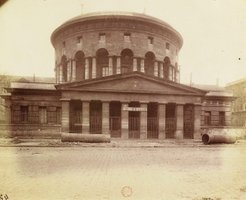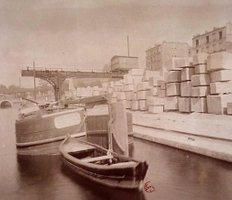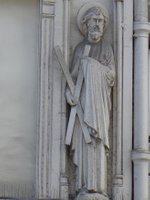Hora fugit - Un peu de Paris
Paris Camino - First part
From the Parc de la Villette to the Church of Saint-Merri
reading 16 min - Stroll 6 kilometers
This first part of the Pilgrimage road within Paris is a rather recent one. It is based on the GR 655 used by pilgrims coming from North and Flanders. It goes through Parc de la Villette and follows Canal de l'Ourcq and Canal de Saint-Martin. A more traditional way is then followed along rue Saint-Martin down to the church of Saint-Merri.
The Parc de la Villette and the canals
In order to bring more fresh water to Paris, Napoleon commissioned the building of a canal from the River Ourcq into a huge water reservoir, the Bassin de la Villette. At this time, they were located outside the city limits. The Bassin de la Villette was later opened to navigation in 1826 and was connected with the Seine river. Up north to Saint-Denis with the Saint Denis canal and to the south with the Saint Martin canal. As a result, new industrial activities developed in the Villette neighborhood, previously a rural area. More especially during the Second Empire with a new major livestock market and slaughterhouses located over a vast area which is today the Parc de la Villette. At this time without refrigerated storage facilities, animals were brought and killed close to where they were to be eaten. Though modernised in the 1960s, the large Villette meat market was no longer corresponding to new more rational methods. In 1977, it was decided to convert most of the buildings into a place devoted to science and technology, to music and other cultural events and transform the land into a vast urban park.
The Camino trail through the Parc de la Villette, marked out on the ground by around twenty nail-shells, gives the opportunity to discover a part of this park.
Let's get to the Parc de la Villette from Porte de la Villette metro station.
From the entry, we can see the Cité des Sciences et de l'Industrie (City of Science and Industry) converted from the former cattle auction hall closed in 1974.
Let's not go toward it. Let's walk alongside the grey building between the park and the street, towards an other building, all red lined, called Maison de la Villette, a pavilion of the former meat market.
When we reach the Pavillon de la Villette, there are several benches on the right, one of which is the bench of the Pilgrims, shaded by a beautiful lime tree.
Keep going to the end and take the path on the left leading to the covered gallery. Under this gallery, there are several nail shells on the ground, confirming we are on the right path.
We now walk along the huge Cité des Sciences et de l'Industrie, now on our left. It is an impressive view with the back of the building surrounded by water and the dome of the Omnimax theatre, la Géode, reflecting the sky.
At the end of the gallery, there is a footbridge to cross the Ourcq canal, from where the old mills of Pantin can be seen on our left. At the bottom of the steps, there are two shell nails. We go down to walk along the Ourcq canal where there is an old blue bus stop, a starting point for an other stroll, a very nice two and a half hour cruise to the Musée d'Orsay.
We now leave the Parc de la Villette and use a little bridge to cross a dock where the two canals Ourcq and Saint-Denis join. We continue along the Canal de l'Ourcq, using Quai de la Marne up to the lift bridge on Rue de Crimée, about 600 metres ahead.
At pont de la Crimée, the two buildings at each side of the bridge were once warehouses for sugar, grain and spirits. One was destroyed by a fire in 1990 and was replaced by a new one on quai de Seine. The other one is today a university residence of the Cité Universitaire.
Let's now take the historic Crimée footbridge across the canal, which can be used by pedestrians even when the impressive 1884 lift bridge is in action; they both represent a nice example of combined design and technology.
From the bridge we have a nice view over the Bassin de la Villette.
Just across from us, the small Place de Bitche with a nice public garden and a small church provides a quiet atmosphere a little bit in contrast with the modern high building. Quite pleasant for a break, away from the traffic. On Thursdays and Sundays, the market behind the church on Place de Joinville can provide the products for a picnic.
The Saint-Jacques–Saint Christophe church is rather recent. It replaced the old 14th century church of La Villette once located in the middle of gardens, orchards and vineyards, along an old Roman road used by the Compostela pilgrims coming from northern provinces. In the 19th century, with the increase of the population around the Ourcq Canal, it was decided to replace the old church with the new neo-classical Saint-Jacques Saint-Christophe church.
Let's now cross back the canal to continue on quai de Loire along the Bassin de la Villette.
In the distance, we can see the Rotonde de la Villette, a former building used to collect taxes on the goods entering Paris.
Compared with the bustling and industrial basin photographed by Atget, the Bassin de la villette is quite different nowadays. Today it is used for canoeing, rowing, pleasure boating and even swimming in summer during the Paris Plages event
Bassin de la Villette – Quai de Loire
Atget – 1914
(MoMA)
Between the photo taken in 1914 and the one almost a hundred years later, nothing is recognisable apart the quay.
With much less style, the green footbridge replaced in 1966 the Moselle footbridge built by Eiffel in 1882. The thirty floors Duvergier Tower, one of the tallest in the 19th arrondissement stands above the dock and water sports have now replaced the former port activities.
We are now at the Rotonde de la Villette, a former tax collection building designed by Nicolas Ledoux, a genious architect. But a very monumental architecture just for a tax building. An opinion certainly shared by the people who set fire to almost all of these tax buildings around Paris on 12 July 1789 just before the storming of the Bastille. This one escaped.
Models of all Ledoux’ buildings can be seen at one of his other masterpiece, the Royal Salines d'Arc et Senans.
Former Toll Building – La Villette
Atget –
(BnF)
Arrived Place Stalingrad, quite busy with a crasy traffic of cars, buses, two-wheelers, bicycles, scooters and the aerial metro, we have to cross Avenue Jean-Jaurès, then Avenue Secrétan, then Boulevard de la Villette and finally pass under the aerial metro to turn left and resume our walk on Quai de Jemmapes, along the Canal Saint-Martin.
Originally planned by Napoleon in 1803, canal Saint-Martin was inaugurated under the Restoration in 1823. It links the Bassin de la Villette to the Port de l'Arsenal, offering a pleasant 4.4 km walk along its banks. Very nice also by boat through nine locks, it offers an amazing moment under boulevard Richard Lenoir and the Bastille column before exiting at the Port de l'Arsenal next to the River Seine.
The canal is regularly cleaned, for that it is completely emptied and dried out. It's always amazing what you can find there, as Boris Vian would have singed …
A fridge,
A beautiful scooter,
A fancy food processor,
A Dunlopillo,
A fancy cooker,
with a glass oven,
A zillion cutlery,
And cake shovels.
it's also done to protect a biodiversity of flora and fauna that we'd never suspect, like eels, freshwater mussels, crayfish, roach ...
Once lined with warehouses and factories, its quays are now busy with many restaurants and bars. One exception is the Clairefontaine-Exacompta factories implemented on the banks of Saint-Martin since 1928, which still make agendas made in Paris!
Quai de Jemmapes
Atget – between 1905 and 1906
(BnF)
Let's now take the bridge between rue des Ecluses Saint-Martin and rue Eugène Varlin. Called in the past the « locks of the dead », because they were near of a former cemetery and also of a pretty scary site: the gallows of Mautfaucon. They were once located at the top of a mound today 53, rue de la Grange aux Belles. Let's quickly move away from this grim and gruesome image and turn left onto the Quai de Valmy.
A little bit ahead of us, the canal is now slightly curving in front of yellow and green little shops. Before that curve, let’s enter in the Villemin garden on our right.
From Jardin Villemin to porte Saint-Martin
In the past there was a convent, called the Récollets converted later in the 19th century into a hospital. It could have been destroyed to be turned into a luxury residence without the efforts of locals and a group of artists squatting the place calling themselves the Angels of Récollets.
The name of Récollets comes from a Latin word : recollectum, meaning meditation. All that remains of this vast religious space is now a building once used as the monks' dormitory and library.
During the French Revolution, the last monks were expelled and the building transformed into a hospice. It became a military hospital, named in 1913 after Villemin, a military doctor renowned for his work on tuberculosis. Located near the Gare de l'Est, the hospital received many soldiers wounded during the wars of 1870, 14-18 and 39-40.
Now as the Maison de l'architecte Ile de France, there is a small Café, Café A with a quiet outdoor courtyard for a quiet break.
Going towards the music kiosk, let's follow the alleyway leading out onto rue des Récollets about 100 metres away. Let's cross the street to take the Passage des Récollets.
In this passage, don't turn right as the passage itself does, but continue straight ahead under the buildings where you find the Passage Dubail. Take a right. Continue in the first lane on the left, pass beneath the two arched buildings to arrive in the rue des Vinaigriers.
Cross the rue des Vinaigriers and then the boulevard de Magenta. Take again the rue des Vinaigriers opposite and turn left into the rue du Faubourg Saint-Martin.
Just after an old house at no. 82 with a Madonna in a small niche, there is the imposing town hall of the 10th district, a sort of a castle combined with a small copy of the Paris Hôtel de Ville.
We arrive at the Porte Saint-Martin, built to the glory of Louis XIV for his victories in Franche-Comté over the German, Spanish and Dutch armies.
Rue Saint-Martin - Priory
We continue straight ahead along the rue Saint-Martin, an ancient Roman road connecting with the northern provinces.
On our left, there is the Vert Bois tower, at the corner of the Conservatoire des Arts et Métiers. It is a vestige of the ancient walls once defending the priory of Saint-Martin.
« Between the Rue Neuve du Temple and the Rue Saint-Martin, in the midst of gardens, stood the Abbey of Saint-Martin, a superb fortified church, whose girdle of towers and crown of steeples were second only to Saint-Germain-des-Prés in strength and splendour. (Victor Hugo – Notre Dame de Paris).
The writer had used all his influence to save and restore Notre-Dame. Later, in 1880, Victor Hugo had also these words to save the Verbois Tower, the only one left but highly bothering for the architect in charge of the Conservatoire extension:
"Demolish the tower? No. Demolish the architect? Yes.
He understands nothing about history and therefore nothing about architecture. From now on , all of of Paris’ old buildings must be kept. Paris is a city of the past. Why? Because it is the city of the future."
Since its creation in 1794 by Abbé Grégoire, the Conservatoire des Arts et Métiers has been housed in the former priory. And the small roman church of Saint-Martin des Champs, today part of the museum contains some of the collections, like Clément Ader's aeroplane and Foucault's pendulum. (An other nice stroll around Arts et Métiers).
We now cross the rue Réaumur and continue along the rue Saint-Martin. On our left is the church of Saint-Nicolas des Champs, originally a chapel belonging to the abbey of Saint-Martin. The current building from the 15th century was enlarged over time as the population grew.
Church of Saint-Nicolas des Champs - Gate
Atget – 1911
(Beaux-Arts)
Hospital Saint-Jacques aux Pèlerins
Let’s cross rue Cunin-Gridaine and rue de Turbigo and stay along rue Saint-Martin until rue aux Ours on the right.
Continue along rue Etienne Marcel all the way to rue Saint-Denis, where we stop in front of the building on the corner.
The Hospital Saint-Jacques, built in 1319 for pilgrims, was once located between rue Saint-Denis and rue Pierre Lescot, one street further on, and rue du Cygne to the south. The hospital was closed down during the French Revolution and virtually nothing remains of it, apart from five statues discovered in 1840 during the construction of new buildings. These statues of the hospital Church were hidden in the ground during the Revolution. They can be seen today in the Musée de Cluny.
Far to be exact copies of the original statues, the three ones on either side of the building intend to be a souvenir of the Hospital Saint-Jacques.
Let’s continue along rue Etienne Marcel and turn into rue Pierre Lescot. At number 17, the 1820 building also reminds the Saint-Jacques hospital with Camino symbols above some windows: scallop shells, pilgrim's staff, gourds and bags. As well, above the main door, the caduceus as a medical symbol.
On this same building, side of rue du Cygne there is also a plaque mentioning the hospital dedicated to the pilgrims making the journey to Santiago de Compostela.
Church of Saint-Leu Saint-Gilles
Let’s continue along rue du Cygne until rue Saint-Denis, that we take on the right.
Right in front of us is the 13th-century church of Saint-Leu Saint-Gilles, rebuilt and modified many times through the centuries. The church is home of the Knights of the Holy Sepulchre, who celebrate their offices in the crypt.
It is often closed, except when masses or concerts are held there. During this stroll, I was lucky enough to find it open late one Wednesday afternoon. I was struck by the peaceful atmosphere of this small Gothic church in contrast with its sad and dirty exterior.
Church of Saint-Merri
We continue along rue Saint-Denis until rue Berger, which we take on the left. Then, we continue along rue Aubry le Boucher and turn right into rue Saint-Martin.
Let’s stop at the church of Saint-Merri. Its bell tower contains the oldest bell in Paris, the "Merry", dating from 1331. During the 16th century with a growing population in a very commercial district, this flamboyant Gothic style church had to be rebuilt. To the right of the porch you will notice saint-Jacques represented as a pilgrim. You will notice as well above the porch, the Baphomet, a strange figure with a beard and horns surrounded by a whole host of animals. A visit to the interior is a must.
Second part of the stroll: From Saint-Jacques Tower to the porte d'Orléans
Texte / Photos : Martine Combes
Contact / newsletter:




